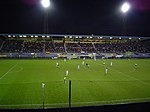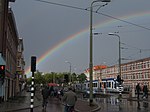Haaglanden

Parts of this article have been translated from the Dutch version of this pageHaaglanden (Dutch pronunciation: [ˈɦaːxlɑndə(n)], literally Haguelands) was a conurbation surrounding The Hague in the Netherlands from 1992 until 2015. The city's position as the country's seat of government made the region prominent in the Netherlands. Located on the west coast of the province of South Holland, the region had a population of 1,050,543 in September 2013, and covered an area of 405 km².Haaglanden was an official term referring to an urban region literally called Haaglanden Urban Region (Stadsgewest Haaglanden). The official website of Haaglanden used the English translation The Hague Region. Another translation would have been the Greater Hague Area. The term was also sometimes used to refer to the conurbation of The Hague in a general, informal sense; "the Hague area" or "the area around The Hague". This area was often treated as a single unit for organisational or statistical purposes. Haaglanden was part of the larger Rotterdam The Hague Metropolitan Area. On 1 January 2015 Haaglanden was merged into the Rotterdam-The Hague metropolitan area. Haaglanden has since only existed as a safety region. Its use for statistical purposes has since been replaced by the Greater The Hague and Delft & Westland COROP regions. In 2018, South Holland province commissioned a study into the economic benefits of reviving the urban region.
Excerpt from the Wikipedia article Haaglanden (License: CC BY-SA 3.0, Authors, Images).Haaglanden
Wesselsstraat, The Hague Centrum
Geographical coordinates (GPS) Address Nearby Places Show on map
Geographical coordinates (GPS)
| Latitude | Longitude |
|---|---|
| N 52.0658 ° | E 4.2967 ° |
Address
Wesselsstraat 68
2572 SH The Hague, Centrum
South Holland, Netherlands
Open on Google Maps









